height OPEL COMBO 2017 Manual user
[x] Cancel search | Manufacturer: OPEL, Model Year: 2017, Model line: COMBO, Model: OPEL COMBO 2017Pages: 195, PDF Size: 4.71 MB
Page 9 of 195
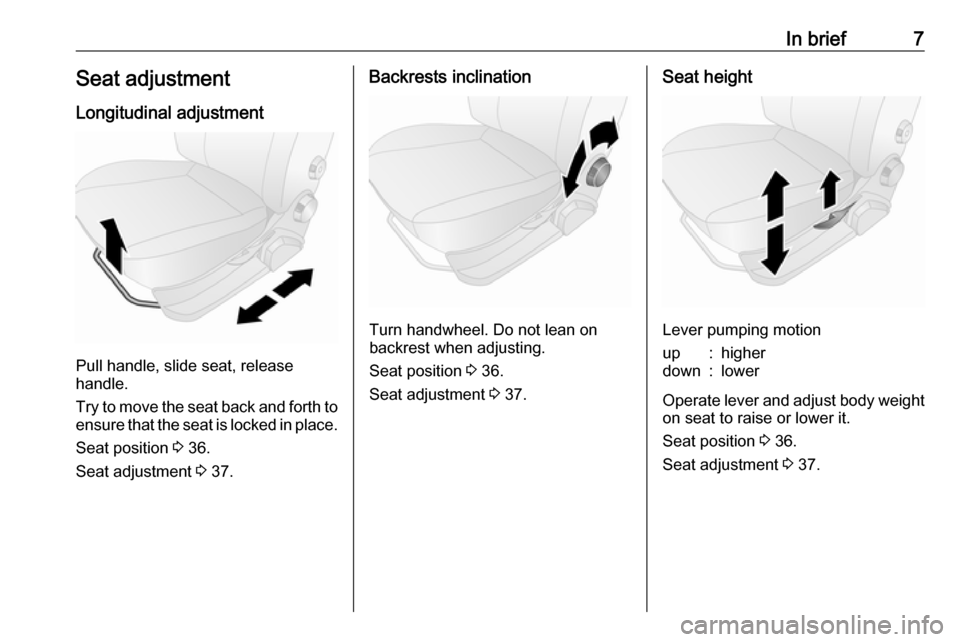
In brief7Seat adjustmentLongitudinal adjustment
Pull handle, slide seat, release
handle.
Try to move the seat back and forth to ensure that the seat is locked in place.
Seat position 3 36.
Seat adjustment 3 37.
Backrests inclination
Turn handwheel. Do not lean on
backrest when adjusting.
Seat position 3 36.
Seat adjustment 3 37.
Seat height
Lever pumping motion
up:higherdown:lower
Operate lever and adjust body weight
on seat to raise or lower it.
Seat position 3 36.
Seat adjustment 3 37.
Page 10 of 195
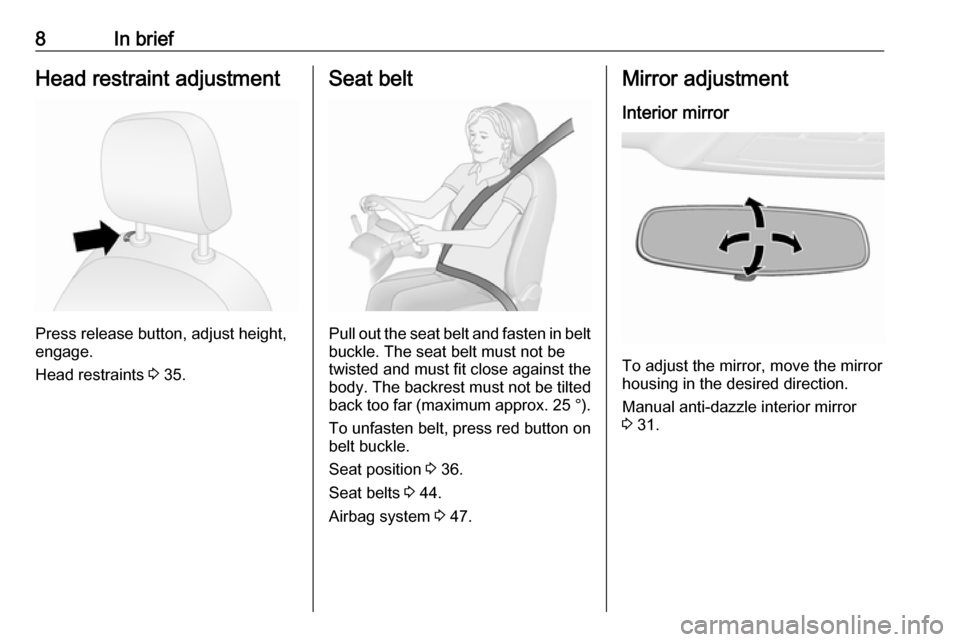
8In briefHead restraint adjustment
Press release button, adjust height,
engage.
Head restraints 3 35.
Seat belt
Pull out the seat belt and fasten in belt
buckle. The seat belt must not be
twisted and must fit close against the
body. The backrest must not be tilted back too far (maximum approx. 25 °).
To unfasten belt, press red button on belt buckle.
Seat position 3 36.
Seat belts 3 44.
Airbag system 3 47.
Mirror adjustment
Interior mirror
To adjust the mirror, move the mirror
housing in the desired direction.
Manual anti-dazzle interior mirror
3 31.
Page 37 of 195
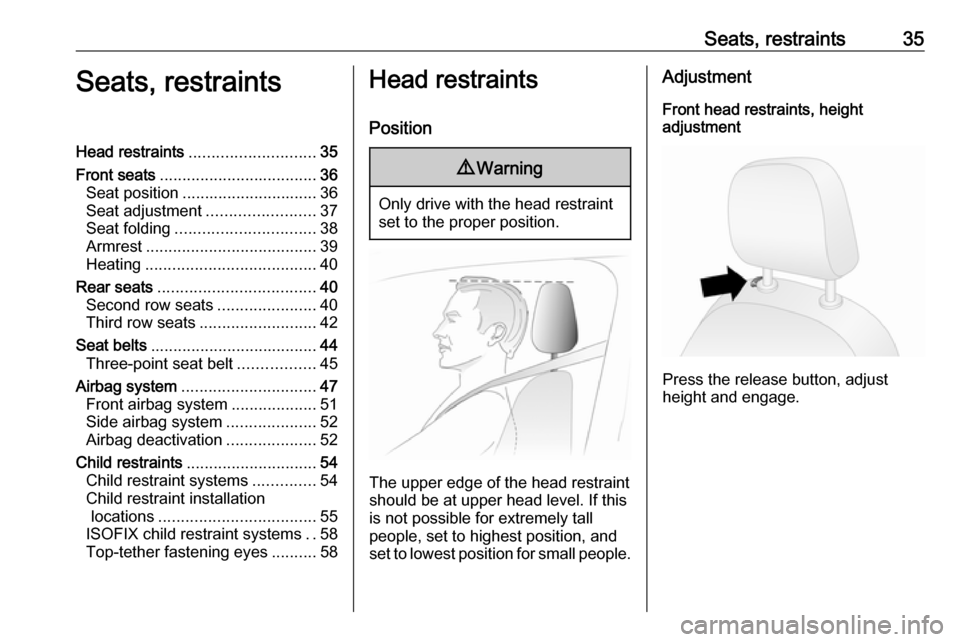
Seats, restraints35Seats, restraintsHead restraints............................ 35
Front seats ................................... 36
Seat position .............................. 36
Seat adjustment ........................37
Seat folding ............................... 38
Armrest ...................................... 39
Heating ...................................... 40
Rear seats ................................... 40
Second row seats ......................40
Third row seats .......................... 42
Seat belts ..................................... 44
Three-point seat belt .................45
Airbag system .............................. 47
Front airbag system ...................51
Side airbag system ....................52
Airbag deactivation ....................52
Child restraints ............................. 54
Child restraint systems ..............54
Child restraint installation locations ................................... 55
ISOFIX child restraint systems ..58
Top-tether fastening eyes ..........58Head restraints
Position9 Warning
Only drive with the head restraint
set to the proper position.
The upper edge of the head restraint
should be at upper head level. If this
is not possible for extremely tall
people, set to highest position, and
set to lowest position for small people.
Adjustment
Front head restraints, height
adjustment
Press the release button, adjust
height and engage.
Page 38 of 195
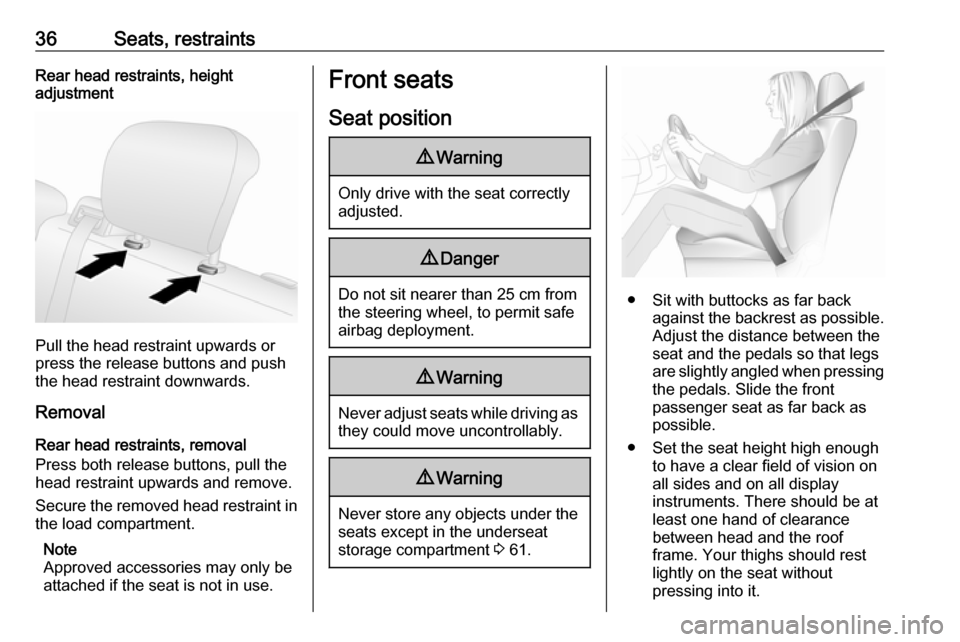
36Seats, restraintsRear head restraints, height
adjustment
Pull the head restraint upwards or
press the release buttons and push
the head restraint downwards.
Removal
Rear head restraints, removal
Press both release buttons, pull the
head restraint upwards and remove.
Secure the removed head restraint in the load compartment.
Note
Approved accessories may only be
attached if the seat is not in use.
Front seats
Seat position9 Warning
Only drive with the seat correctly
adjusted.
9 Danger
Do not sit nearer than 25 cm from
the steering wheel, to permit safe
airbag deployment.
9 Warning
Never adjust seats while driving as
they could move uncontrollably.
9 Warning
Never store any objects under the
seats except in the underseat
storage compartment 3 61.
● Sit with buttocks as far back
against the backrest as possible.
Adjust the distance between the
seat and the pedals so that legs
are slightly angled when pressing the pedals. Slide the front
passenger seat as far back as
possible.
● Set the seat height high enough to have a clear field of vision on
all sides and on all display
instruments. There should be at
least one hand of clearance
between head and the roof
frame. Your thighs should rest
lightly on the seat without
pressing into it.
Page 39 of 195
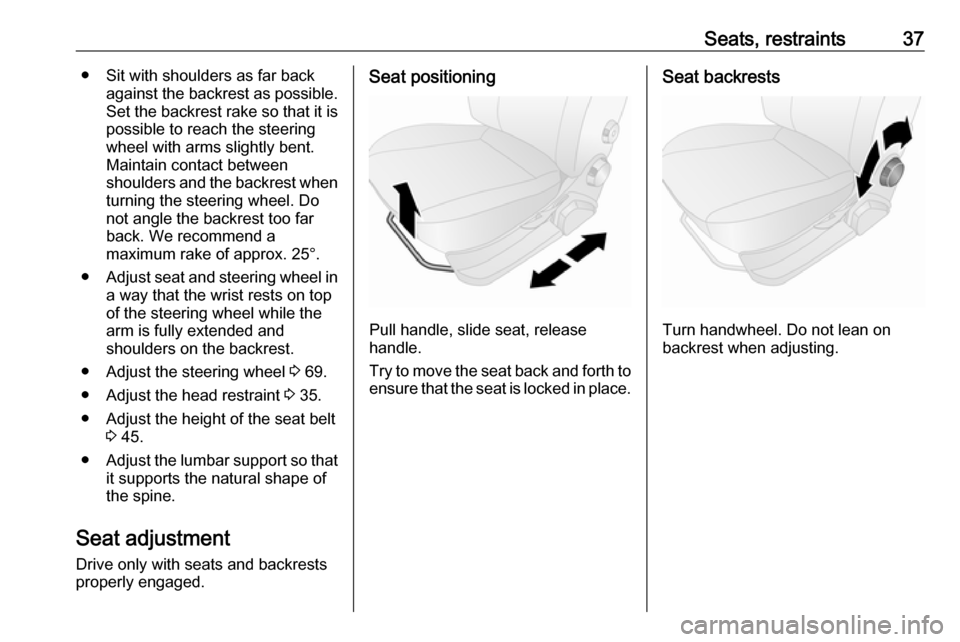
Seats, restraints37● Sit with shoulders as far backagainst the backrest as possible.
Set the backrest rake so that it is possible to reach the steering
wheel with arms slightly bent.
Maintain contact between
shoulders and the backrest when turning the steering wheel. Do
not angle the backrest too far
back. We recommend a
maximum rake of approx. 25°.
● Adjust seat and steering wheel in
a way that the wrist rests on top
of the steering wheel while the
arm is fully extended and
shoulders on the backrest.
● Adjust the steering wheel 3 69.
● Adjust the head restraint 3 35.
● Adjust the height of the seat belt 3 45.
● Adjust the lumbar support so that
it supports the natural shape of
the spine.
Seat adjustment
Drive only with seats and backrests properly engaged.Seat positioning
Pull handle, slide seat, release
handle.
Try to move the seat back and forth to ensure that the seat is locked in place.
Seat backrests
Turn handwheel. Do not lean on
backrest when adjusting.
Page 40 of 195
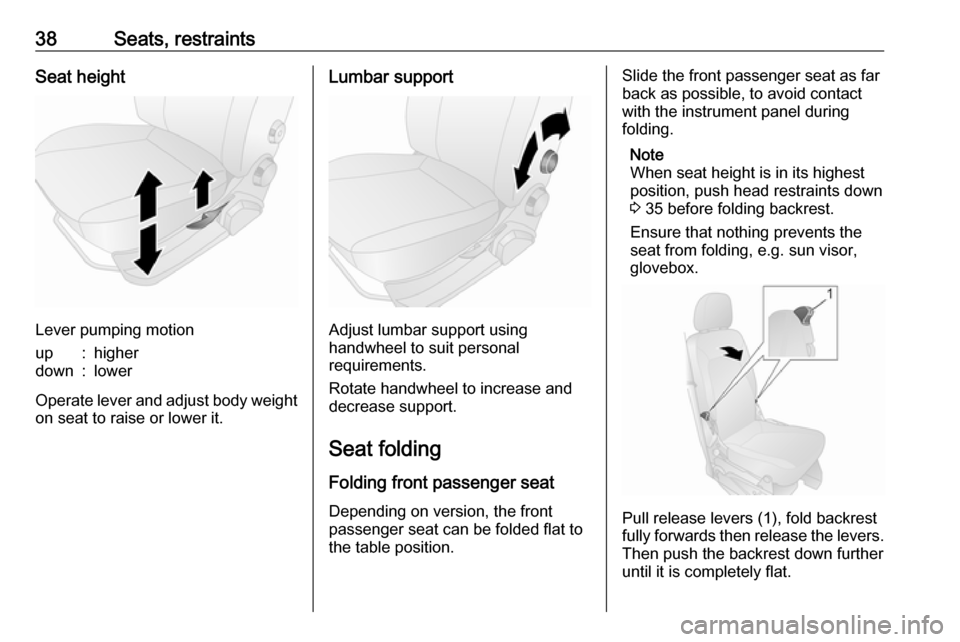
38Seats, restraintsSeat height
Lever pumping motion
up:higherdown:lower
Operate lever and adjust body weight
on seat to raise or lower it.
Lumbar support
Adjust lumbar support using
handwheel to suit personal
requirements.
Rotate handwheel to increase and
decrease support.
Seat folding Folding front passenger seatDepending on version, the front
passenger seat can be folded flat to
the table position.
Slide the front passenger seat as far
back as possible, to avoid contact
with the instrument panel during
folding.
Note
When seat height is in its highest
position, push head restraints down
3 35 before folding backrest.
Ensure that nothing prevents the
seat from folding, e.g. sun visor,
glovebox.
Pull release levers (1), fold backrest
fully forwards then release the levers. Then push the backrest down further
until it is completely flat.
Page 48 of 195
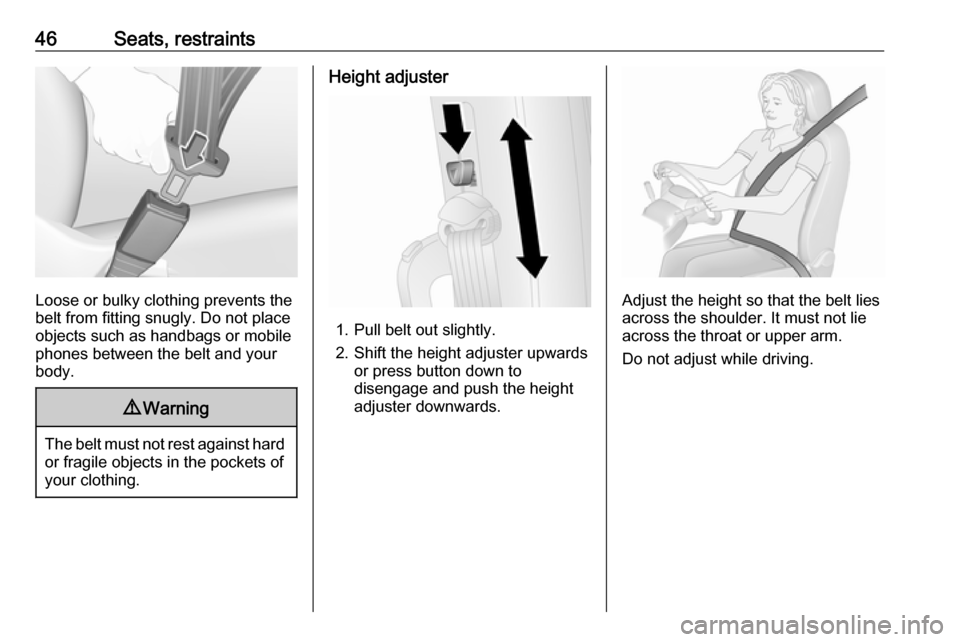
46Seats, restraints
Loose or bulky clothing prevents the
belt from fitting snugly. Do not place
objects such as handbags or mobile
phones between the belt and your body.
9 Warning
The belt must not rest against hard
or fragile objects in the pockets of
your clothing.
Height adjuster
1. Pull belt out slightly.
2. Shift the height adjuster upwards or press button down todisengage and push the height
adjuster downwards.
Adjust the height so that the belt lies
across the shoulder. It must not lie
across the throat or upper arm.
Do not adjust while driving.
Page 57 of 195

Seats, restraints55Child restraint installation locations
Permissible options for fitting a child restraint system
Weight and age class
Front passenger seatSecond rowThird rowactivated airbagdeactivated airbagoutboard seatcentre seatGroup 0: up to 10 kg
or approx. 10 monthsXU 1U,
or approx. 6 to 12 yearsXXUUX1:When securing with a three-point seat belt, move seat height adjustment to uppermost position and ensure that the
seat belt runs forwards from the upper anchorage point. Adjust seat backrest inclination as far as necessary to a
vertical position to ensure that the belt is tight on the buckle side.<:Vehicle seat available with ISOFIX attachments. When attaching using ISOFIX, only the ISOFIX child restraint
systems permitted for the vehicle may be used.U:Universal suitability in conjunction with three-point seat belt.X:No child restraint system permitted in this weight class.
Page 142 of 195
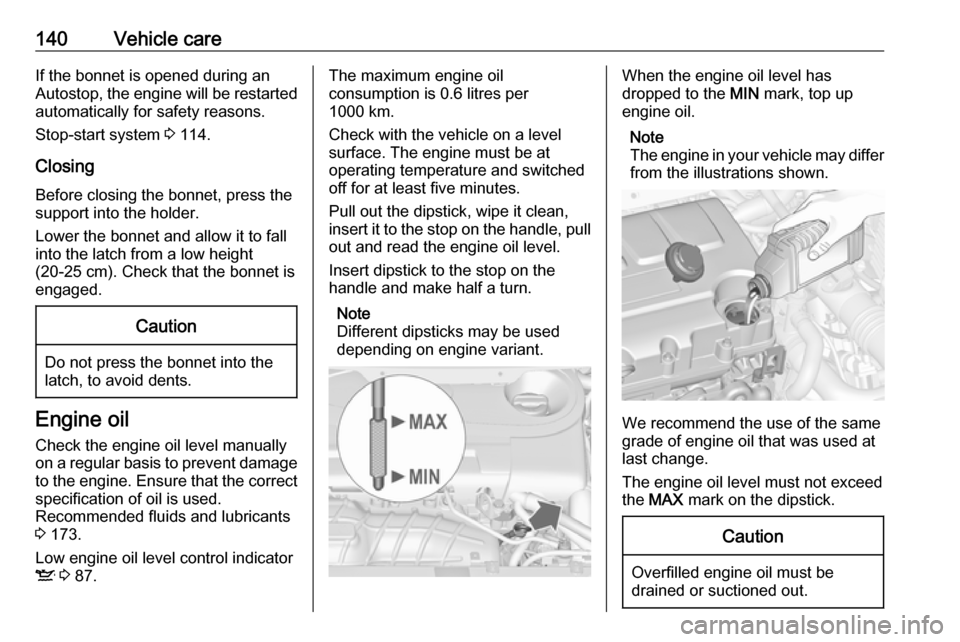
140Vehicle careIf the bonnet is opened during anAutostop , the engine will be restarted
automatically for safety reasons.
Stop-start system 3 114.
Closing Before closing the bonnet, press the
support into the holder.
Lower the bonnet and allow it to fall
into the latch from a low height
(20-25 cm). Check that the bonnet is
engaged.Caution
Do not press the bonnet into the
latch, to avoid dents.
Engine oil
Check the engine oil level manually
on a regular basis to prevent damage
to the engine. Ensure that the correct specification of oil is used.
Recommended fluids and lubricants
3 173.
Low engine oil level control indicator
S 3 87.
The maximum engine oil
consumption is 0.6 litres per
1000 km.
Check with the vehicle on a level
surface. The engine must be at
operating temperature and switched
off for at least five minutes.
Pull out the dipstick, wipe it clean,
insert it to the stop on the handle, pull
out and read the engine oil level.
Insert dipstick to the stop on the
handle and make half a turn.
Note
Different dipsticks may be used
depending on engine variant.When the engine oil level has
dropped to the MIN mark, top up
engine oil.
Note
The engine in your vehicle may differ from the illustrations shown.
We recommend the use of the same
grade of engine oil that was used at
last change.
The engine oil level must not exceed
the MAX mark on the dipstick.
Caution
Overfilled engine oil must be
drained or suctioned out.
Page 157 of 195
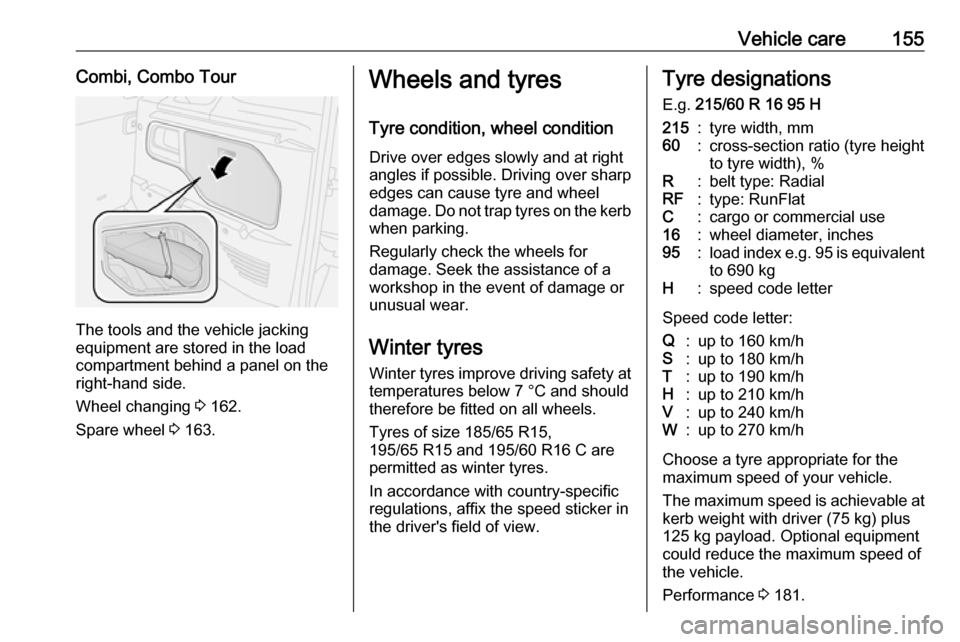
Vehicle care155Combi, Combo Tour
The tools and the vehicle jacking
equipment are stored in the load
compartment behind a panel on the
right-hand side.
Wheel changing 3 162.
Spare wheel 3 163.
Wheels and tyres
Tyre condition, wheel condition
Drive over edges slowly and at right
angles if possible. Driving over sharp
edges can cause tyre and wheel
damage. Do not trap tyres on the kerb when parking.
Regularly check the wheels for
damage. Seek the assistance of a
workshop in the event of damage or
unusual wear.
Winter tyres Winter tyres improve driving safety at
temperatures below 7 °C and should
therefore be fitted on all wheels.
Tyres of size 185/65 R15,
195/65 R15 and 195/60 R16 C are
permitted as winter tyres.
In accordance with country-specific
regulations, affix the speed sticker in
the driver's field of view.Tyre designations
E.g. 215/60 R 16 95 H215:tyre width, mm60:cross-section ratio (tyre height
to tyre width), %R:belt type: RadialRF:type: RunFlatC:cargo or commercial use16:wheel diameter, inches95:load index e.g. 95 is equivalent to 690 kgH:speed code letter
Speed code letter:
Q:up to 160 km/hS:up to 180 km/hT:up to 190 km/hH:up to 210 km/hV:up to 240 km/hW:up to 270 km/h
Choose a tyre appropriate for the
maximum speed of your vehicle.
The maximum speed is achievable at kerb weight with driver (75 kg) plus
125 kg payload. Optional equipment
could reduce the maximum speed of
the vehicle.
Performance 3 181.